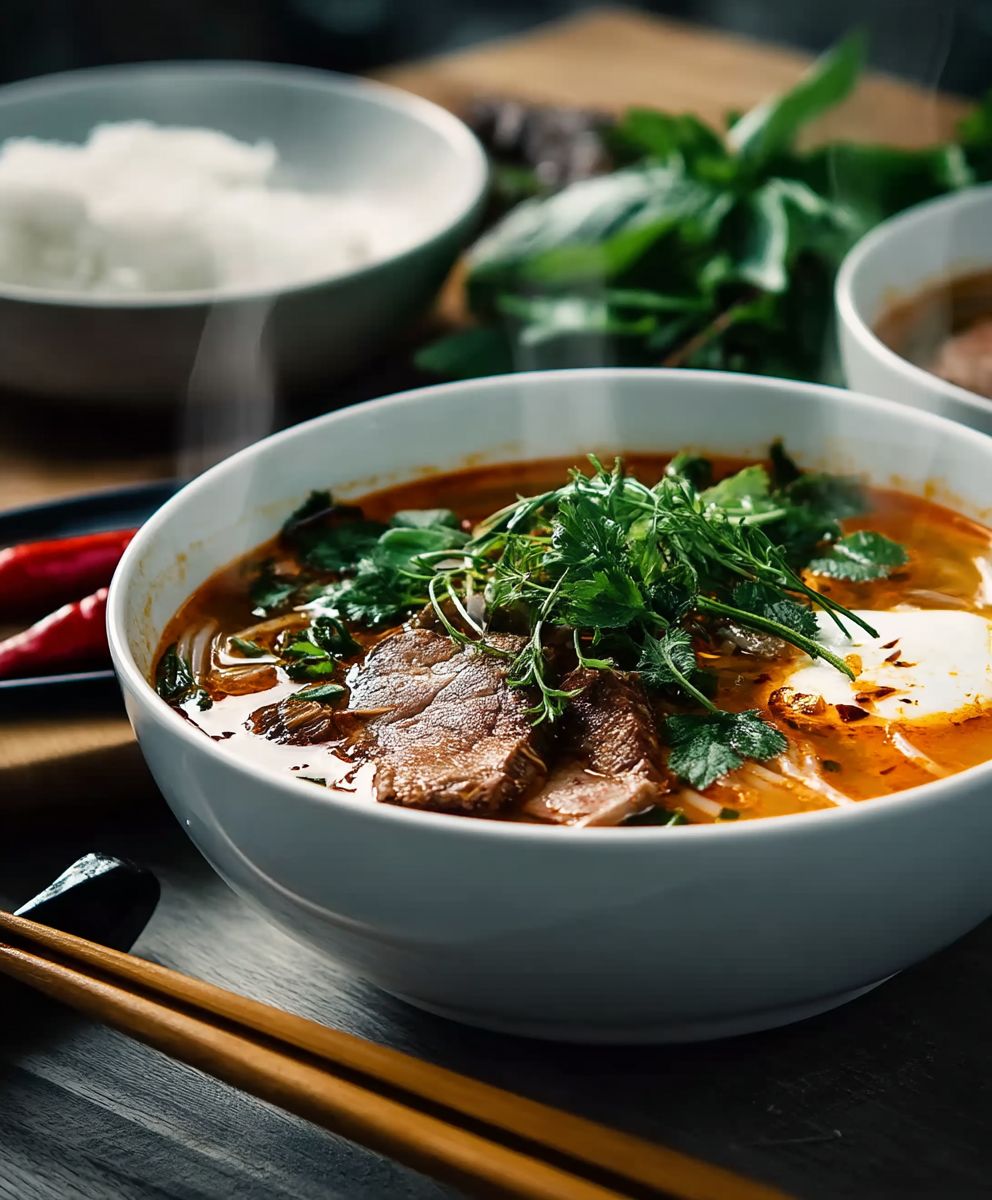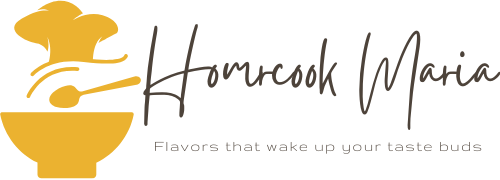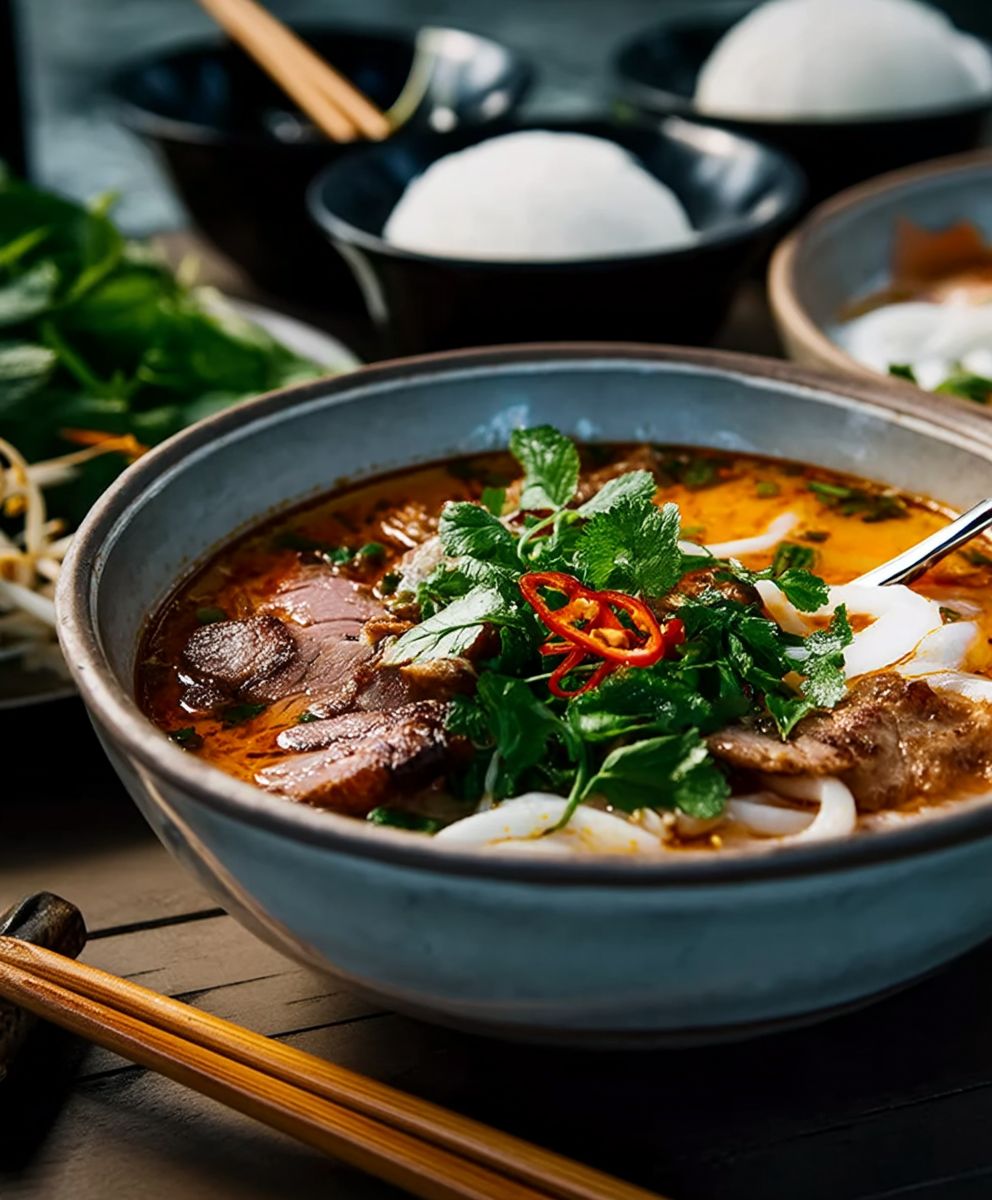Bun Bo Hue, a symphony of spicy, savory, and umami flavors, is about to become your new favorite noodle soup! Forget everything you thought you knew about Vietnamese cuisine; this isn’t your average pho. Imagine a bowl brimming with thick rice noodles, tender slices of beef shank, and flavorful pork, all swimming in a rich, lemongrass-infused broth that will tantalize your taste buds.
Originating from the imperial city of Hue in central Vietnam, Bun Bo Hue was once a dish reserved for royalty. Its complex preparation and unique blend of ingredients reflected the region’s rich culinary heritage. While its exact origins are shrouded in history, it’s believed to have evolved from simpler noodle soups enjoyed by the common people, gradually incorporating more luxurious ingredients and sophisticated techniques to please the palates of the imperial court.
What makes this dish so irresistible? It’s the perfect balance of textures and tastes. The chewy noodles, the melt-in-your-mouth beef, the crispy herbs, and the fiery chili oil all come together in a harmonious explosion of flavor. People love it for its depth, its complexity, and its ability to warm you from the inside out. Plus, while it might seem intimidating, making your own Bun Bo Hue at home is surprisingly achievable with the right guidance. So, are you ready to embark on a culinary adventure and discover the magic of Bun Bo Hue?
Ingredients:
- For the Broth:
- 3 lbs beef shank or beef chuck, bone-in
- 2 lbs pork hock
- 1 large onion, charred
- 3 stalks lemongrass, bruised
- 2-inch piece of ginger, charred
- 1 tbsp shrimp paste (m?m ru?c)
- 2 tbsp annatto oil (d?u màu ?i?u)
- 2 tbsp chili flakes (adjust to taste)
- 1 tbsp sugar
- 2 tbsp fish sauce (n??c m?m)
- 1 tsp salt (or to taste)
- 10 cups water (or more as needed)
- For the Noodles and Toppings:
- 1 lb thick rice vermicelli noodles (bún bò Hu?)
- 1/2 lb thinly sliced beef (e.g., flank steak or sirloin)
- 1/2 lb Vietnamese pork sausage (ch? l?a), sliced
- 1/2 cup cooked pig’s blood cubes (optional)
- 1/2 cup sliced scallions
- 1/4 cup chopped cilantro
- 1/4 cup thinly sliced white onion
- Lime wedges, for serving
- Bean sprouts, for serving
- Banana blossom, shredded, for serving
- Mint leaves, for serving
- Vietnamese coriander (rau r?m), for serving
- Chili oil, for serving (optional)
Preparing the Broth:
- Blanch the Meats: In a large stockpot, combine the beef shank and pork hock with enough cold water to cover. Bring to a boil over high heat. Once boiling, let it simmer for about 5-10 minutes. This process helps to remove impurities and create a cleaner broth. Drain the meats and rinse them thoroughly under cold water. Clean the stockpot as well.
- Char the Aromatics: Char the onion and ginger directly over an open flame on your stovetop until they are blackened on all sides. This step enhances their flavor and adds a smoky depth to the broth. You can also broil them in the oven if you prefer. Once charred, rinse them under cold water to remove the burnt outer layer. Bruise the lemongrass stalks by gently pounding them with the back of a knife. This releases their aromatic oils.
- Simmer the Broth: Return the blanched meats to the cleaned stockpot. Add the charred onion, charred ginger, and bruised lemongrass. Pour in 10 cups of water (or more, ensuring the meats are fully submerged). Bring the mixture to a boil, then reduce the heat to low and simmer gently for at least 3 hours, or even longer for a richer flavor. Skim off any scum that rises to the surface during the simmering process. This is crucial for a clear and flavorful broth.
- Season the Broth: After simmering for 3 hours, remove the beef shank and pork hock from the pot. Set them aside to cool slightly. In a small bowl, mix the shrimp paste with a few tablespoons of the hot broth until it is fully dissolved. This ensures even distribution of the shrimp paste flavor. Add the dissolved shrimp paste, annatto oil, chili flakes, sugar, fish sauce, and salt to the broth. Stir well to combine. Taste and adjust the seasoning as needed. Remember that the broth should be slightly salty and spicy, as these flavors are characteristic of Bun Bo Hue.
- Prepare the Meats: Once the beef shank and pork hock have cooled enough to handle, shred the beef shank meat with two forks. You can also slice it into bite-sized pieces. For the pork hock, you can either shred the meat or leave it in larger chunks, depending on your preference. Return the shredded beef shank and pork hock meat to the broth.
Preparing the Noodles and Toppings:
- Cook the Noodles: While the broth is simmering, prepare the rice vermicelli noodles according to the package directions. Typically, this involves soaking them in hot water until they are softened, then draining them thoroughly. Be careful not to overcook the noodles, as they will become mushy.
- Prepare the Beef: If using raw beef slices, quickly sear them in a hot pan or briefly blanch them in the hot broth just before serving. This ensures that they are cooked through but still tender. Alternatively, you can add the raw beef slices directly to the bowl of hot broth, where they will cook from the heat of the broth.
- Assemble the Toppings: Slice the Vietnamese pork sausage (ch? l?a) into thin rounds. Prepare the other toppings by slicing the scallions, cilantro, and white onion. Shred the banana blossom if using. Have all the toppings readily available for assembling the bowls.
Assembling the Bun Bo Hue:
- Portion the Noodles: Divide the cooked rice vermicelli noodles among individual serving bowls.
- Add the Meats: Top the noodles with the shredded beef shank, pork hock, and sliced Vietnamese pork sausage. If using, add the cooked pig’s blood cubes.
- Ladle the Broth: Ladle the hot broth over the noodles and meats, ensuring that everything is well submerged.
- Garnish and Serve: Garnish each bowl with sliced scallions, cilantro, and white onion. Serve immediately with lime wedges, bean sprouts, shredded banana blossom, mint leaves, Vietnamese coriander (rau r?m), and chili oil on the side. Let everyone customize their bowl to their liking.
Tips for the Best Bun Bo Hue:
- Broth is Key: The broth is the heart and soul of Bun Bo Hue. Don’t rush the simmering process. The longer you simmer the broth, the richer and more flavorful it will become.
- Quality Ingredients: Use high-quality ingredients, especially for the shrimp paste and fish sauce. These ingredients contribute significantly to the overall flavor of the dish.
- Adjust the Spice Level: Bun Bo Hue is known for its spiciness. Adjust the amount of chili flakes to your preference. You can also add chili oil to each bowl for an extra kick.
- Fresh Herbs: Don’t skimp on the fresh herbs. They add a refreshing and aromatic element to the dish.
- Customize Your Bowl: Bun Bo Hue is a very customizable dish. Feel free to add or omit ingredients based on your personal preferences.
Variations:
- Vegetarian Bun Bo Hue: To make a vegetarian version, use vegetable broth instead of beef and pork broth. Replace the meats with tofu or mushrooms. Use vegetarian shrimp paste or omit it altogether.
- Seafood Bun Bo Hue: Add shrimp, squid, or other seafood to the broth for a seafood twist.
- Chicken Bun Bo Hue: Use chicken broth and shredded chicken instead of beef and pork.
Serving Suggestions:
- Serve Bun Bo Hue hot and fresh.
- Offer a variety of toppings and condiments so that everyone can customize their bowl.
- Pair Bun Bo Hue with a refreshing Vietnamese iced coffee (cà phê s?a ?á) or a cold beer.
Enjoy your homemade Bun Bo Hue! I hope you find this recipe helpful and that it brings you a taste of Vietnam right in your own kitchen. Don’t be intimidated by the long ingredient list or the simmering time. The end result is well worth the effort. The complex flavors and satisfying textures of Bun Bo Hue will surely impress your family and friends. Happy cooking!

Conclusion:
This isn’t just another soup recipe; it’s an invitation to experience the vibrant, complex flavors of Vietnam right in your own kitchen. I truly believe this Bun Bo Hue recipe is a must-try for anyone who appreciates bold, aromatic, and deeply satisfying cuisine. From the lemongrass-infused broth to the tender slices of beef and the satisfying chew of the rice noodles, every element works in perfect harmony to create a culinary masterpiece.
But what truly sets this recipe apart is its versatility. While I’ve provided a detailed guide to achieving the authentic taste of Bun Bo Hue, feel free to experiment and adapt it to your own preferences. Craving even more heat? Add an extra chili or two to the broth. Prefer a richer, more decadent flavor? A touch of shrimp paste can elevate the umami notes to new heights.
And don’t feel limited to just beef! While it’s the traditional protein, you can easily substitute it with pork, chicken, or even tofu for a vegetarian option. The key is to ensure that whatever protein you choose is cooked to perfection and complements the other flavors in the soup.
Speaking of serving suggestions, Bun Bo Hue is incredibly satisfying on its own, but it’s even better when accompanied by a generous platter of fresh herbs and vegetables. Think bean sprouts, shredded lettuce, sliced banana blossoms, mint, cilantro, and lime wedges. These fresh additions not only add a burst of color and texture but also provide a refreshing counterpoint to the richness of the broth. A side of chili oil or sate is also a welcome addition for those who like to dial up the spice.
For a truly authentic experience, consider serving your Bun Bo Hue in large bowls, allowing plenty of room for the noodles, broth, and toppings. And don’t forget the chopsticks and a soup spoon essential tools for navigating this delicious culinary adventure!
Beyond the traditional accompaniments, feel free to get creative with your serving suggestions. A sprinkle of crispy fried shallots adds a delightful crunch, while a drizzle of sesame oil enhances the aroma and flavor. You can even add a soft-boiled egg for an extra layer of richness and protein.
Ultimately, the best way to enjoy Bun Bo Hue is to make it your own. Don’t be afraid to experiment with different ingredients, adjust the spice level to your liking, and create a version that perfectly suits your taste buds.
I’m so excited for you to embark on this culinary journey and discover the magic of Bun Bo Hue. I’ve poured my heart and soul into this recipe, and I’m confident that you’ll be thrilled with the results.
So, what are you waiting for? Gather your ingredients, put on your apron, and get ready to create a truly unforgettable meal. And most importantly, don’t forget to share your experience with me! I’d love to hear about your variations, your serving suggestions, and any tips or tricks you discover along the way. Tag me in your photos on social media, leave a comment below, or simply send me an email. I can’t wait to see what you create! Happy cooking! I hope you enjoy this Bun Bo Hue as much as I do!
Bun Bo Hue: A Spicy & Authentic Vietnamese Noodle Soup Recipe
Spicy Vietnamese noodle soup with rich beef broth, tender beef shank, pork hock, and fresh herbs.
Ingredients
- 3 lbs beef shank or beef chuck, bone-in
- 2 lbs pork hock
- 1 large onion, charred
- 3 stalks lemongrass, bruised
- 2-inch piece of ginger, charred
- 1 tbsp shrimp paste (m?m ru?c)
- 2 tbsp annatto oil (d?u màu ?i?u)
- 2 tbsp chili flakes (adjust to taste)
- 1 tbsp sugar
- 2 tbsp fish sauce (n??c m?m)
- 1 tsp salt (or to taste)
- 10 cups water (or more as needed)
- 1 lb thick rice vermicelli noodles (bún bò Hu?)
- 1/2 lb thinly sliced beef (e.g., flank steak or sirloin)
- 1/2 lb Vietnamese pork sausage (ch? l?a), sliced
- 1/2 cup cooked pig’s blood cubes (optional)
- 1/2 cup sliced scallions
- 1/4 cup chopped cilantro
- 1/4 cup thinly sliced white onion
- Lime wedges, for serving
- Bean sprouts, for serving
- Banana blossom, shredded, for serving
- Mint leaves, for serving
- Vietnamese coriander (rau r?m), for serving
- Chili oil, for serving (optional)
Instructions
- Blanch the Meats: In a large stockpot, combine the beef shank and pork hock with enough cold water to cover. Bring to a boil over high heat. Once boiling, let it simmer for about 5-10 minutes. Drain the meats and rinse them thoroughly under cold water. Clean the stockpot as well.
- Char the Aromatics: Char the onion and ginger directly over an open flame on your stovetop until they are blackened on all sides. Rinse them under cold water to remove the burnt outer layer. Bruise the lemongrass stalks by gently pounding them with the back of a knife.
- Simmer the Broth: Return the blanched meats to the cleaned stockpot. Add the charred onion, charred ginger, and bruised lemongrass. Pour in 10 cups of water (or more, ensuring the meats are fully submerged). Bring the mixture to a boil, then reduce the heat to low and simmer gently for at least 3 hours, or even longer for a richer flavor. Skim off any scum that rises to the surface during the simmering process.
- Season the Broth: After simmering for 3 hours, remove the beef shank and pork hock from the pot. Set them aside to cool slightly. In a small bowl, mix the shrimp paste with a few tablespoons of the hot broth until it is fully dissolved. Add the dissolved shrimp paste, annatto oil, chili flakes, sugar, fish sauce, and salt to the broth. Stir well to combine. Taste and adjust the seasoning as needed.
- Prepare the Meats: Once the beef shank and pork hock have cooled enough to handle, shred the beef shank meat with two forks. You can also slice it into bite-sized pieces. For the pork hock, you can either shred the meat or leave it in larger chunks, depending on your preference. Return the shredded beef shank and pork hock meat to the broth.
- Cook the Noodles: While the broth is simmering, prepare the rice vermicelli noodles according to the package directions. Typically, this involves soaking them in hot water until they are softened, then draining them thoroughly.
- Prepare the Beef: If using raw beef slices, quickly sear them in a hot pan or briefly blanch them in the hot broth just before serving. Alternatively, you can add the raw beef slices directly to the bowl of hot broth, where they will cook from the heat of the broth.
- Assemble the Toppings: Slice the Vietnamese pork sausage (ch? l?a) into thin rounds. Prepare the other toppings by slicing the scallions, cilantro, and white onion. Shred the banana blossom if using. Have all the toppings readily available for assembling the bowls.
- Portion the Noodles: Divide the cooked rice vermicelli noodles among individual serving bowls.
- Add the Meats: Top the noodles with the shredded beef shank, pork hock, and sliced Vietnamese pork sausage. If using, add the cooked pig’s blood cubes.
- Ladle the Broth: Ladle the hot broth over the noodles and meats, ensuring that everything is well submerged.
- Garnish and Serve: Garnish each bowl with sliced scallions, cilantro, and white onion. Serve immediately with lime wedges, bean sprouts, shredded banana blossom, mint leaves, Vietnamese coriander (rau r?m), and chili oil on the side. Let everyone customize their bowl to their liking.
Notes
- The broth is the heart and soul of Bun Bo Hue. Don’t rush the simmering process. The longer you simmer the broth, the richer and more flavorful it will become.
- Use high-quality ingredients, especially for the shrimp paste and fish sauce.
- Adjust the amount of chili flakes to your preference.
- Don’t skimp on the fresh herbs.
- Bun Bo Hue is a very customizable dish. Feel free to add or omit ingredients based on your personal preferences.

